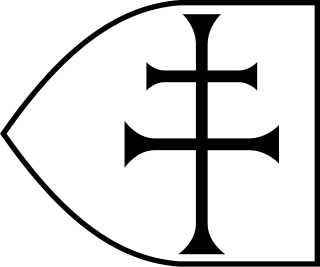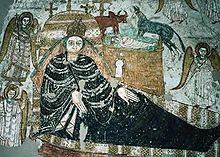
Copts are a Christian ethnoreligious group indigenous to North Africa who have primarily inhabited the area of modern Egypt since antiquity. They are the largest Christian denomination in Egypt and the Middle East, as well as in Sudan and Libya. Copts in Egypt account for roughly 5–15 percent of the Egyptian population; Copts in Sudan account for 1 percent of the Sudanese population, while Copts in Libya similarly account for 1 percent of the Libyan population.
Nubians are a Nilo-Saharan ethnic group indigenous to the region which is now Northern Sudan and southern Egypt. They originate from the early inhabitants of the central Nile valley, believed to be one of the earliest cradles of civilization. In the southern valley of Egypt, Nubians differ culturally and ethnically from Egyptians, although they intermarried with members of other ethnic groups, especially Arabs. They speak Nubian languages as a mother tongue, part of the Northern Eastern Sudanic languages, and Arabic as a second language.
The 2019 transitional constitution of Sudan guarantees freedom of religion and omits reference to sharia as a source of law, unlike the 2005 constitution of Sudan's deposed president Omar al-Bashir whose government had criminalized apostasy and blasphemy against Islam. Bashir's government had also targeted Shia Muslims and those engaging in proselytization to faiths other than Islam. Christians had also faced restrictions in matters of religious freedom.

Makuria was a medieval Nubian kingdom in what is today northern Sudan and southern Egypt. Its capital was Dongola in the fertile Dongola Reach, and the kingdom is sometimes known by the name of its capital.

Islam is the most common religion in Sudan and Muslims have dominated national government institutions since independence in 1956. According to UNDP Sudan, the Muslim population is 97%, including numerous Arab and non-Arab groups. The remaining 3% ascribe to either Christianity or traditional animist religions. Muslims predominate in all but Nuba Mountains region. The vast majority of Muslims in Sudan adhere to Sunni Islam of Maliki school of jurisprudence, deeply influenced with Sufism. There are also some Shia communities in Khartoum, the capital. The most significant divisions occur along the lines of the Sufi brotherhoods. Two popular brotherhoods, the Ansar and the Khatmia, are associated with the opposition Umma and Democratic Unionist Parties respectively. Only the Darfur region is traditionally lacking the presence of Sufi brotherhoods found in the rest of the country.

Alodia, also known as Alwa, was a medieval kingdom in what is now central and southern Sudan. Its capital was the city of Soba, located near modern-day Khartoum at the confluence of the Blue and White Nile rivers.

The dominant religion in Sudan is Islam practiced by around 90.7% of the nation's population. Christianity is the largest minority faith in country accounting for around 5.4% of the population. A substantial population of the adherents of traditional faiths is also present.

Christianity in Africa arrived in Africa in the 1st century AD and in the 21st century, the majority of Africans are Christians. Several African Christians influenced the early development of Christianity and shaped its doctrines, including Tertullian, Perpetua, Felicity, Clement of Alexandria, Origen of Alexandria, Cyprian, Athanasius and Augustine of Hippo. In the 4th century, the Aksumite empire in modern-day Ethiopia and Eritrea became one of the first regions in the world to adopt Christianity as its official religion, followed by the Nubian kingdoms of Nobatia, Makuria and Alodia and several Christian Berber kingdoms.

Christianity is the second largest religion in Egypt. The vast majority of Egyptian Christians are Copts. As of 2019, Copts in Egypt make up approximately 10 percent of the nation's population, with an estimated population of 9.5 million or 10 million. In 2018, approximately 90% of Egyptian Christians were Coptic Orthodox.

Christianity is a minority religion in Libya. It has been present in Tripolitania and Cyrenaica since Roman times.

The Christian community in Qatar is a diverse mix of European, North and South American, Asian, Middle Eastern and African expatriates. In 2023, they form around 15.4% of the total population. Many of them are from the Philippines, Europe, and India. Most Christians in Qatar are not Arab Christians.
Protestants are about 2,009,374 in Sudan. They are forbidden to proselytize. The law makes apostasy punishable by death. The southern ethnic groups fighting the civil war largely are followers of traditional indigenous religions or Christians.

Christianity, which originated in the Middle East during the 1st century AD, is a significant minority religion within the region, characterized by the diversity of its beliefs and traditions, compared to Christianity in other parts of the Old World. Christians now make up approximately 5% of the Middle Eastern population, down from 13% in the early 20th century. Cyprus is the only Christian majority country in the Middle East, with Christians forming between 76% and 78% of the country's total population, most of them adhering to Eastern Orthodox Christianity. Lebanon has the second highest proportion of Christians in the Middle East, around 40%, predominantly Maronites. Egypt has the next largest proportion of Christians, at around 10% of its total population. Copts, numbering around 10 million, constitute the single largest Christian community in the Middle East.

Islam is the dominant religion in Libya.
Oriental Orthodoxy is the communion of Eastern Christian Churches that recognize only three ecumenical councils—the First Council of Nicaea, the First Council of Constantinople and the Council of Ephesus. They reject the dogmatic definitions of the Council of Chalcedon. Hence, these Churches are also called Old Oriental Churches or Non-Chalcedonian Churches.

Christianity is the most widely professed religion in South Sudan, with significant minorities of the adherents of traditional faiths and Islam.

The Catholic Church in South Sudan is composed of one ecclesiastical province with one archdiocese and six suffragan dioceses. There have been a total of 31 bishops in South Sudan to date. The bishops of South Sudan and Sudan are currently members of one single bishops' conference, designated as Sudan Catholic Bishops’ Conference.

Sudan has a native Coptic minority, although many Copts in Sudan are descended from more recent Coptic immigrants from Egypt. Copts in Sudan live mostly in northern cities, including Al Obeid, Atbara, Dongola, Khartoum, Omdurman, Port Sudan, and Wad Medani. They number between 400,000-500,000, or slightly over 1% of the Sudanese population. Due to their advanced education, their role in the life of the country has been more significant than their numbers suggest.



















